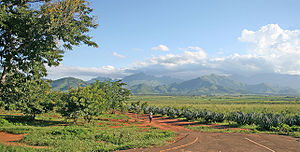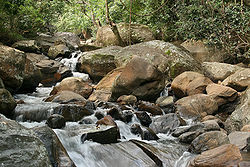
Uluguru Mountains
Encyclopedia
The Uluguru Mountains are a mountain range
in eastern Tanzania
, Africa
, named after the Luguru tribe. The main Uluguru Mountains is a ridge running approximately north-south and rising to 2,630 m altitude at its highest point. On the main Uluguru range, 50 villages touch the forest boundary and over 151,000 people are found within the mountain area, often at increasing densities at higher altitudes up to the forest boundary.
. They are part of a chain of mountains in eastern Africa collectively called the Eastern Arc Mountains
, which include the Taita Hills
, Pare Mountains
, Usambara Mountains
, Nguru Mountains
, Rubeho, Ukaguru, Udzungwa Mountains
and Mahenge Mountains
.
 The vegetation of the Uluguru main ridge and the outlying blocks is extremely variable. It ranges from drier lowland coastal forest habitats, to transitional rainforests, to sub-montane, montane and upper montane forest types.
The vegetation of the Uluguru main ridge and the outlying blocks is extremely variable. It ranges from drier lowland coastal forest habitats, to transitional rainforests, to sub-montane, montane and upper montane forest types.
and the east facing slopes are especially wet, with rainfall estimated at over 3,000 mm per annum, with some rain falling in every month.
 The forests of the mountains provide the water catchment areas for the streams and rivers. This water flows mainly from the forest-capped peaks of the Ulugurus with the streams joining to form the Ruvu river, which provides the water supply to the city of Dar es Salaam
The forests of the mountains provide the water catchment areas for the streams and rivers. This water flows mainly from the forest-capped peaks of the Ulugurus with the streams joining to form the Ruvu river, which provides the water supply to the city of Dar es Salaam
. Most of the neighboring population, around 3 million people, and the major industries in Tanzania rely on this water supply for their continued survival. The loss of the Uluguru forests and any reduction in water supply potential of the mountains could therefore have a drastic impact on the human well-being and the industrial capacity of Tanzania.
Mountain range
A mountain range is a single, large mass consisting of a succession of mountains or narrowly spaced mountain ridges, with or without peaks, closely related in position, direction, formation, and age; a component part of a mountain system or of a mountain chain...
in eastern Tanzania
Tanzania
The United Republic of Tanzania is a country in East Africa bordered by Kenya and Uganda to the north, Rwanda, Burundi, and the Democratic Republic of the Congo to the west, and Zambia, Malawi, and Mozambique to the south. The country's eastern borders lie on the Indian Ocean.Tanzania is a state...
, Africa
Africa
Africa is the world's second largest and second most populous continent, after Asia. At about 30.2 million km² including adjacent islands, it covers 6% of the Earth's total surface area and 20.4% of the total land area...
, named after the Luguru tribe. The main Uluguru Mountains is a ridge running approximately north-south and rising to 2,630 m altitude at its highest point. On the main Uluguru range, 50 villages touch the forest boundary and over 151,000 people are found within the mountain area, often at increasing densities at higher altitudes up to the forest boundary.
Geography
The Ulugurus lie 200 km inland from the Indian OceanIndian Ocean
The Indian Ocean is the third largest of the world's oceanic divisions, covering approximately 20% of the water on the Earth's surface. It is bounded on the north by the Indian Subcontinent and Arabian Peninsula ; on the west by eastern Africa; on the east by Indochina, the Sunda Islands, and...
. They are part of a chain of mountains in eastern Africa collectively called the Eastern Arc Mountains
Eastern Arc Mountains
The Eastern Arc Mountains are a chain of mountains found in Kenya and Tanzania. It comprises:* Taita Hills* North and South Pare* East and West Usambara* North and South Nguru* Ukaguru* Uluguru Mountains* Rubeho* Udzungwa Mountains* Mahenge Escarpment...
, which include the Taita Hills
Taita Hills
The Taita Hills, sometimes also spelled as Teita Hills, are a precambrian mountain range in the south-west of Kenya in Taita-Taveta District. The hills consist of three massifs namely Dabida, Sagalla in the southern side of Voi township and Kasigau in the south near the border of Tanzania...
, Pare Mountains
Pare Mountains
The Pare Mountains are a mountain range in north eastern Tanzania, north west of the Usambara Mountains. There are two mountain ranges - North and South Pare ranges, which rise to 2,463 m at Shengena Peak. They form part of the Eastern Arc of mountains. The Pare people live in the area.The Pare...
, Usambara Mountains
Usambara Mountains
The Usambara Mountains are a mountain range in North-East Tanzania, approximately long and ranging from 20 to in width. Mountains in the range rise as high as 8,000 ft ....
, Nguru Mountains
Nguru Mountains
The Nguru Mountains are a mountain range in Morogoro District, Tanzania, Africa. The mountains are predominantly covered with rainforest, are abundant with 83 species of bird life , and are the home of African violets...
, Rubeho, Ukaguru, Udzungwa Mountains
Udzungwa Mountains
The Udzungwa Mountains are a mountain range south east of Dodoma in Tanzania and are part of the Eastern Arc Mountains. They are covered with tropical rainforest, mountain forest, miombo woodland, grassland, steppe and are home to many large mammals, including the Udzungwa Red Colobus and Tana...
and Mahenge Mountains
Mahenge
Mahenge is a limestone plateau area in the Ulanga District, Morogoro Region, Tanzania, Africa. There is a town there of the same name. It is about south east of Singida, in the miombo woodland bio-region....
.
Vegetation

Climate
Climatically, the Uluguru mountains capture moisture passing inland from the Indian OceanIndian Ocean
The Indian Ocean is the third largest of the world's oceanic divisions, covering approximately 20% of the water on the Earth's surface. It is bounded on the north by the Indian Subcontinent and Arabian Peninsula ; on the west by eastern Africa; on the east by Indochina, the Sunda Islands, and...
and the east facing slopes are especially wet, with rainfall estimated at over 3,000 mm per annum, with some rain falling in every month.
Water Catchment

Dar es Salaam
Dar es Salaam , formerly Mzizima, is the largest city in Tanzania. It is also the country's richest city and a regionally important economic centre. Dar es Salaam is actually an administrative province within Tanzania, and consists of three local government areas or administrative districts: ...
. Most of the neighboring population, around 3 million people, and the major industries in Tanzania rely on this water supply for their continued survival. The loss of the Uluguru forests and any reduction in water supply potential of the mountains could therefore have a drastic impact on the human well-being and the industrial capacity of Tanzania.

